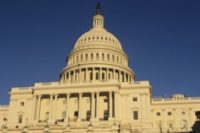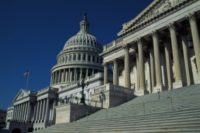Environmental Regulations
$ GHG Regulations — The Environmental Protection Agency (EPA) announced in December 2010 that it would propose Clean Air Act GHG New Source Performance Standards for electric generating units and petroleum refineries in 2011. EPA recently has announced that it will not propose NSPS for petroleum refineries until 2013. However, on March 27, 2012, EPA released its proposed NSPS for new electric generating units larger than 25 MW. This proposed rule would require all new powerplants to emit no more than 1,000 lbs of carbon dioxide per megawatt hour generated. This emissions level is roughly equivalent to emissions from a new combined cycle natural gas turbine, thus effectively eliminating new coal-fired powerplants unless equipped with carbon capture and sequestration technologies, technologies that today are not commercially or economically available. While EPA has indicated that it has no current plans to extend the NSPS to existing powerplants, the Clean Air Act may make that position untenable, thus calling into question the impact on the existing coal fleet, which is also facing new requirements pursuant to the utility MACT rule, emissions reductions under the Cross-State Air Pollution Rule and possibly new investments pursuant to the upcoming Cooling Water Intake Structures rule (316(b) of the Clean Water Act).
$ Hydraulic Fracturing — Multiple federal agencies are considering regulating hydraulic fracturing. The EPA has finalized a suite of new regulations for the oil and natural gas industry, including the first federal air standard for wells that are hydraulically fractured. These regulations include a new source performance standard for volatile organic compounds; a new source performance standard for sulfur dioxide; an air toxics standard for oil and natural gas production; and an air toxics standard for natural gas transmission and storage.
$ PM2.5 — The Clean Air Act requires the EPA to promulgate primary and secondary National Ambient Air Quality Standards (NAAQS) for six air pollutants, including PM. Primary standards have been established for PM10 (course particles) and PM2.5 (fine particles). A required five-year review of the PM NAAQS is in progress, and a proposal to retain or revise those standards is expected this year. Power plants, forest fires, wood-burning fireplaces and stoves, on-road and off-road vehicles, agriculture, and construction activities are major sources of PM. Substantial reductions in PM have occurred and are likely to continue to .
Health Care Taxes and Regulations
$ Health Care Taxes — The health care reform law imposed several taxes on insurance plans, medical devices, pharmaceutical products and employer-sponsored health plans. One such tax is an excise tax on health insurance issuers and sponsors of self-funded group health plans with aggregate expenses that exceed $10,200 for individual coverage and $27,500 for family coverage. The amount of the excise tax is 40 percent of an amount considered to be an excess benefit. The health care reform law also added an annual fee on health insurance providers beginning in 2014. The health care reform law imposed a tax on fully insured and self-insured products to finance comparative effectiveness research (Internal Revenue Service [IRS] Notice 2011-35), imposing the tax in 2012 for most policies and plan sponsors. In addition, the Department of Health and Human Services released a proposed rule requiring all insurance plans and plan sponsors to contribute funding to state exchange reinsurance programs. The final rule is pending at OMB.
$ Definition of Full-Time and Part-Time Employees —Starting in 2014, large employers will be assessed a penalty if they fail to provide affordable health insurance, at a minimum value, to any full-time employee who is then found eligible for a tax credit through the Exchange. In May 2011, the IRS proposed that a full-time employee be defined as one who has 130 hours of service in a calendar month, and that this is treated as the monthly equivalent of at least 30 hours of service per week. Treasury and the IRS are also considering a look-back/stability period safe harbor under which an employer would determine each employee’s full-time status by looking back at their hours over a defined period of not less than three, but not more than twelve consecutive calendar months, as chosen by the employer.
Financial Regulations
$ Implementation of the Volcker Rule — Section 619 of Dodd-Frank (Volcker Rule) aims to limit proprietary trading by banks. It will introduce new complexities and impose higher costs for businesses while slowing down the creation of new markets. The Volcker Rule is likely to reduce market liquidity by limiting the market-making and underwriting activities of market participants, thus increasing market volatility and costs.
$ Derivatives Regulation — While the new regulatory structure for OTC derivatives is not yet completed, concerns are increasing over how the rules could restrict the use of derivatives to manage risks associated with business activities. The proposed new rules will create a burdensome structure that will make it more costly to enter into swaps. With more cash required to cover the increased costs imposed by regulation (including higher margin requirements), there will be less money for new job creation and growth. Managing and hedging risk is essential for many businesses, particularly with respect to increasingly volatile commodity prices, currencies and interest rates.
$ Conflict Minerals Disclosure — The Securities and Exchange Commission (SEC) proposed rules in December 2010 to implement Section 1502 of the Dodd-Frank Act, which requires public companies to disclose annually whether their products contain “conflict minerals” (i.e., gold, tin, tantalum and tungsten from the Democratic Republic of the Congo [DRC] or adjoining countries). The SEC’s proposed rules provide for a three-step process that requires companies to (1) determine if conflict minerals are necessary to the functionality of a product they manufacture or “contract to manufacture”; (2) undertake a “reasonable country of origin inquiry” to determine if their conflict minerals originated in the DRC or adjoining countries; and (3) provide an audited Conflict Minerals Report if the conflict minerals in its products, or those it contracts to manufacture, originate in the DRC or adjoining countries or it is unable to determine that they do not.



